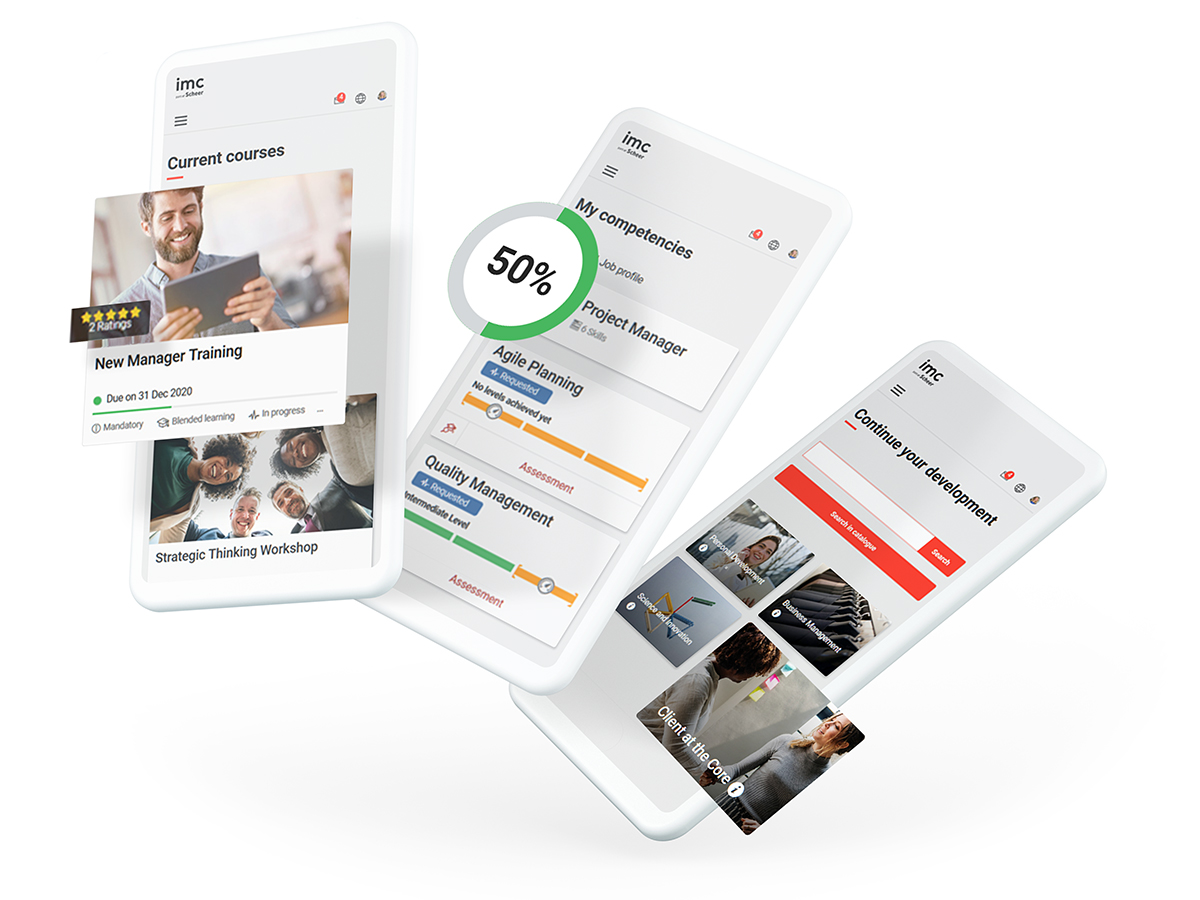
Creating the Perfect Learning Experience for a Remote or Hybrid Workforce
Times have changed for L&D - while many large organisations were already putting resources into digital transformation, our workforce is now more dispersed, with hybrid and remote working looking like it’s here to stay even post-Covid.
Alongside these trends, we have ubiquitous access to more information through ever-faster Internet and mobile devices, while top talent expect to be supported in their professional development - otherwise, they will move on.
What remains the same are people and their motivations. People are fundamental to any company, and what drives a company forward and helps it to stay afloat in a competitive market is an engaged, well-informed and adaptable workforce.
Here we look at how to facilitate the personal and professional development of top talent by creating the perfect learning experience for a remote or hybrid workforce, so that training can become a key competitive advantage.

Technology and a Learning Ecosystem
Keeping your workforce at the forefront of your industry requires regular formal training, but also informal and rapid knowledge sharing between employees and departments.
The ability to respond quickly to new products, services, industry guidance and competitive environments through learning will give any company a competitive edge, but this can be diminished when working remotely.
Whether we’re training face-to-face, digitally or virtually, the fundamentals have remained the same for a very long time; we’re socially motivated learners who need context, reinforcement and practice to acquire new skills. We don’t respond well to formless, monotone, poorly presented content, and we don’t retain information as effectively when we’re not engaged. Making your learning journey engaging, enticing and efficient is where technology can come in.
Technology has revolutionised how we design and deliver learning experiences. Today, learners expect a digital training experience that’s accessible, flexible and engaging.
They’re used to platforms such as Netflix that neatly package and categorise content for them, and offer a library and playlists with a user-friendly interface.

There are a wide variety of digital and online tools that can help learners have a positive learning experience. These are especially useful when it comes to mandatory training, such as for legal or industry compliance, which employees know they need to undertake but may not necessarily be enthusiastic about.
It doesn’t matter how engaging and talented your experts may be, if the platforms and tools you’re using to host a learning journey aren’t up to scratch then your learner will find it difficult to focus.
When seamlessly integrated, there are 3 key L&D tools that can help you create the perfect learning experience even when your teams are disparate. These are the LMS, LXP, and rapid content authoring tools - let’s examine each in turn.
What is a Learning Management System?
A Learning Management System (LMS) maintains, tracks and records a learner's journey, including analysing their comprehension of subject matter and completion of learning events. An LMS will help L&D managers track an individual's or a group’s progress through training by serving as a system of record and audit, and pinpointing where they may need additional help or support.
There are several types of Learning Management System which meet various needs and budgets, including open source software, deployed or Software as a Service (SaaS) solutions. An open source solution is free at the point of access and has a committed online community that will update it regularly, rolling out improvements and add-ons for all to use. It can be a good option for companies with tight budgets who desire something to enhance their learning experience without breaking the bank. However, it can be a security risk without expert set-up and support, and can often be plain and uninspiring out of the box, requiring a great deal of design and customisation - all of which comes at a cost of course.
A hosted or Software as a Service (SaaS) system runs on someone else's server, is set up by a provider and may offer a more customised solution compared to open source software. These systems are usually quite ready to use out of the box.
A deployed LMS solution is set up on computers within your premises, which has its pros and cons. There are greater up-front costs to install the LMS software on-site, but it may save you more money in the long run. This might be a good choice in highly regulated industries and when you have the in-house technical expertise to maintain it.
Historically, the LMS can be unintuitive, unattractive and complex for the user, making it difficult to navigate and read or watch the learning content. In some cases, a badly designed LMS can create more of a hurdle to learning than the content itself.

The best LMS, such as what can be found within imc’s Learning Suite, create an easy to use learning journey though, so that learning can be an engaging activity rather than a chore.
An LMS is often seen as a solution for top-down training mandated (or at least encouraged by) the employer. It’s not really designed for self-motivated learners to explore new learning opportunities. This is where a Learning Experience Platform can come in…
What is a Learning Experience Platform?
A Learning Experience Platform (LXP) is the Netflix of the learning technology world. A quality learning experience is designed to entice, encourage and excite learners to consume the content. It’s for self-motivated learning to develop their personal and professional knowledge and skills, which in turn will usually bear fruit for the employer too.
The LXP is designed to be more intuitive to use than the LMS, and utilised effectively, it should provide contextualised, relevant and custom content from multiple sources in order to cater for different learning styles and preferences.
It’s a diverse learning ecosystem of multimedia content exploration.
LXPs enable you to create a personalised experience that can curate and recommend the best content for each person.
We were talking earlier about how hard it can be to motivate people to undertake essential, mandatory training, such as compliance. Well, an expertly executed LXP should make learning feel fun and easy for your learner, yes really - fun, and in turn, hopefully, it will help employees to feel supported and valued, and help to create a culture of learning within an organisation.
Think of the difference between using Netflix or scrolling a government site, what one would you prefer to use? The more at ease and enthused your learners feel in their learning environment the better their journey will be.
The imc Learning Suite combines the best of both an LMS and LXP - giving L&D teams what they need to deliver and track training, and giving employees a place to explore learning opportunities for personal and professional development.
What are rapid content authoring tools and how can they help me create quality training content?
Rapid content authoring tools are a form of software that enables experts to create and package learning content using various forms of media. It means your experts or training managers can create new content, make changes and send updates to learners quickly and easily. The working landscape is ever evolving, especially in post-covid times with hybrid working becoming the norm, and tools such as rapid content authoring empower companies to respond swiftly to changes and stay relevant.
Adopting content authoring tools can enhance your digital transformation journey as a company, empowering experts and learning and development professionals to create adaptive engaging content promptly.
Rapid content authoring tools can help you:
- Repurpose existing content quickly
- Keep development costs low
- Respond swiftly to new products, services, market or environmental changes
- Update and upscale content quickly
- Deliver knowledge in easy-to-digest chunks
- Share content with learners on any device
Content-authoring tools include software Articulate Storyline, Adobe Captivate, Lectora and Camtasia. However, you might have in-house subject matter experts willing and ready to create and share their experience and expertise if they can avoid the learning curve of software used by professional instructional designers.
imc Express enables the quick creation of elearning materials that are rich, engaging and multimedia, but without that learning curve.

What is a healthy learning ecosystem?
A learning ecosystem comprises the elements that make up your user's learning journey and environment including the tools, platforms and technologies. Just like the natural ecosystem, the more diverse the learning environment, the more effective the learning will be.
A complete, well-integrated Learning Suite can enhance not only your learners' experience but your subject matter experts' effectiveness too, enabling them to build engaging content and communicate quickly and efficiently to drive knowledge sharing.

A complete learning experience
Technology helps learners have a positive learning experience, especially when it comes to compulsory training where they may lack the motivation to complete.
Learners today expect training to be engaging, entertaining and diverse in format. This is especially true as remote and hybrid working is on the rise and our workforce becomes more distributed.
People are looking for social connection, a platform that is instinctive to use and easy to digest content that they can absorb and experience digitally or virtually. The latest and best in learning technology can help us achieve all of this.
Want to learn more about leveraging the latest technology to create the perfect learning experience for a remote or hybrid workforce? Contact us here at imc Learning.

Turning a learning curve into an earning curve
Set online training up for success in such an extended enterprise learning scenario, and how to turn a learning curve into an earning curve.

Learning Management System for Membership Organisations
Make your platform effective for current and future training needs for your membership organisation.